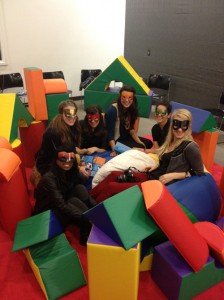The exciting conclusion to my interview about ArtGameLab with its curator Erica Gangsei, Manager of Interpretive Media at the San Francisco Museum of Modern Art. You can read the first part of the interview over here.
Sara Thacher: Now for the questions I’ve been aching to ask: Several of the games encourage what some might see as disruptive or transgressive behavior inside of the museum such as “Incite a rebellion inside SFMOMA” or “Install your own art at SFMOMA.” Was there any discussion around whether to include these?
Erica Gangsei: There was never any discussion about whether or not to include them! Some of the most potentially-concerning instructions are actually some of my favorites, such as “Silently follow another visitor and document their encounters with the art.” or “Tempt someone out of SFMOMA and eat them. Provide video documentation.” Often in museums we follow implicit rules that prescribe certain types of behaviors. Instructions that encourage transgressive behavior inside the museum make us question those rules. That said, I hope that visitors will be respectful of the art and of each others’ enjoyment of the museum. ;)
I gave the Visitor Services staff a full training, so they were prepared for unorthodox behaviors. We’ve had a few “rebellions” inside the museum (no self-installed artwork yet, to my knowledge) and all have occurred without incident.
ST: Oh wow – I didn’t know you’d had actual rebellions. I might have to revise my original impression of those assignments as simply ‘thought experiments.’ What happened during these rebellions? Any other good stories of people playing the games?

All six characters from "I Know What I Like" plot a revolution (the Bold task for one character) inside the SFMOMA Family Programs “Art Basics” castle.
EG: Well, the girls in this photo are the best story so far. They came to the museum specifically for ArtGameLab because they loved the Jejune Institute and heard that there was an ARG available. They checked out character masks for I Know What I Like and spent the rest of the day in character as they played every single game in the exhibition. This shot is them plotting their rebellion inside our family programs Art Basics castle. Moments later, blocks were thrown. We don’t have any reports of visitors eating each other yet, nor have I received a single Zork mixtape (hint to the readers!) but we remain ever hopeful.
ST: How did the games evolve after they were selected? Were there any parts of the original proposals that needed to be changed or reworked due to museum operations or other considerations?
EG: I selected each of the games based on strength and clarity of initial concept. It was very important to me that each of the games in ArtGameLab represent different and distinct game types. We’ve got an ARG, and RPG, a Multiplayer Online Game, a Performance/Parlor game and a Word game. In each case, I worked directly with the game designers to give feedback on ways to make the activities more effective for visitors, or simply more practically applicable within the galleries. I see a lot of museum games and educational activities, and I hope that my expertise made each activity stronger over all. That said, each game is truly the work of the game designer – their voice, their aesthetic, their overall concept.
ST: How much did you work with other departments in terms of getting clearance for game activities or installations?
EG: Good question! Museums are incapable of displaying anything, even something qualified as and experiment, without a layer of polish and packaging. I worked with an in-house editor, Amanda Glesmann, who proofed the text of each of the games for grammar and clarity. Our graphic designers Sophine Lim and Dan McKinley created the gorgeous wall treatments – a deep teal with silver squiggles that connote a circuit board, mad scientists or submarine as much as a game board, calling on ever-deeper levels of metaphor of experimentation, tinkering, exploration. They also held my hand through developing a template for the game designers to present their instructions, and assisted in printing. John Holland from exhibitions led the install, and came up with ingenious solutions for the various cards, drop boxes and, my personal favorite, a “popomatic bubble” for the dice in our RPG.
There was a fair amount of collaboration with other departments, but the activities did not require any additional clearance – my colleagues were very supportive. There is one mysterious object label installed next to something that is not, well, part of SFMOMA’s collection. I had to get special permission from our Director of Operations to put that label up, but he was really on board once I explained it. That’s the great thing about working at a modern and contemporary art museum, everybody’s pretty cool.
ST: What did you discover along the way, either in terms of the responses that you got to the call or the experience of curating the selected games?
EG: As a medium, games are at a crossroads right now and I think that we will go in every single direction out of that crossroads.
Games teach us things implicitly as well as explicitly. We don’t always know what we’re going to learn when we’re playing a game, just as we don’t always know what we’re going to learn or experience during a museum visit. In the same vein, I did not know exactly what ArtGameLab was going to teach me. Many museums are using games right now to meet their visitor experience and educational mandates, what I really wanted to do with the project was to open up the dialogue and ask basic questions:
- Is playing a game a good way to spend time in a museum?
- In what ways are you already playing a game inside a museum? What are the rules, the objectives? What does WINNING look like?
- One of the great things about games, and about museums, is that we are learning things and solving problems that are not necessary in our practical lives. How do we preserve that open-endedness while deepening engagement?
Also, I learned that designing good games is hard! I am so thankful for the game-designers, performers, conceptual artists who put their time and creative energy into the ArtGameLab call for proposals. And I’ve met so many amazing new people since curating ArtGameLab.
Really, what I’ve learned is how much more there is out there. I really hope that this is just the first step down a long road, going in several directions!
ST: Thanks Erica! I hope this experiment paves the way for much more play in the museum, and I look forward to seeing the what new ways to experience the galleries you’ll create next.
This is the second part of a two-part interview – read the first half here. Can’t get enough? Erica will be hosting ‘Museum as Game Board’ a panel discussion tonight (4/19) at SFMOMA. The event hashtag is #ArtGameLab for those who want to follow on Twitter from afar. All of the ArtGameLab games are available for play through August 12 at the Koret Visitor Education Center at SFMOMA.
If you can’t make it to the museum, I posted a review of my experience. Erica also has a great paper, Real-Life Mad Science Experiments in Visitor Engagement, that presented at the recent Museums and the Web Conference in San Diego.
The ArtGameLab games include:
- The Peculiar Scholarship of Dr. Bedcannon, by the Elsewhere Philatelic Society
- Super Going, by Situate
- I Know What I Like, by the Institute for Aesthletics
- Dialogues in Motion, by Benjamin Carpenter and Sudhu Tewari
- Didactic Mad Libs, by the Meaning Makers

